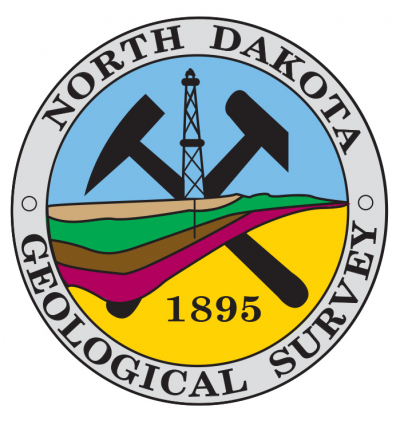If the ND Industrial Commission gives permission to proceed with the rule making process, the NDAC 43-02-02.6 draft rules will be posted here on the morning of December 17. The Department of Mineral Resources – Geological Survey will hold a public hearing to address proposed new rules, Exploration and Production of Critical Minerals in Coal-Bearing Formations, N.D. Admin. Code 43-02-02.5., at 1:30pm on Tuesday, January 20, 2026, at 1000 Calgary Avenue, Bismarck. |

Edward C. Murphy, State Geologist
Welcome to the North Dakota Geological Survey.
After nearly 130 years, the North Dakota Geological Survey still serves as the primary source of geological information in the state. Its mission over the years has grown and is now three-fold:
One of the most important things that NDGS geologists do is - interpret the geologic history of the state. In turn, through Survey fieldwork and studies, a large amount of geological information can be obtained from NDGS publications; comprehensive collections of cores, samples, and fossils; oil and gas records; and coal and subsurface mineral records. Survey investigations add to the overall understanding of our surroundings for the benefit of everyone.
The Geological Survey publishes maps and reports on the mineralogical, paleontological, and geochemical resources of North Dakota, including oil and gas, coal, uranium, clay, sand and gravel, volcanic ash, potash and other salts, etc. In addition to the mapping of subsurface resources, the Survey is actively mapping the surface geology throughout the state with an emphasis on urban areas and the identification of geohazards such as landslides. NDGS geologists also keep detailed records of slope failure events to respond to future geohazard assessment, avoidance, and mitigation inquiries.
Survey publications support the regulatory programs of the North Dakota Industrial Commission, as well as other state and federal agencies, and assist mineral companies, geotechnical consulting firms, city and county governments, landowners, and citizens of the state.
The North Dakota Geological Survey regulates coal exploration, subsurface mineral exploration and development (this includes all elements, minerals, and compounds other than oil and gas, sand and gravel, and coal), geothermal facilities (both commercial and residential), the Class III Underground Injection Control Program, and paleontological resources on state-owned lands.
The Geological Survey and the Oil and Gas Division are in the Department of Mineral Resources.
- The main office of the Department of Mineral Resources is located at 1016 East Calgary Avenue in Bismarck.
- The Paleontology program of the Geological Survey is housed in the Clarence Johnsrud Paleontology Laboratory in the North Dakota Heritage Center (state museum) on the State Capitol grounds in Bismarck.
- The North Dakota State Fossil Collection, as well as the State Rock and Mineral Collection, are also housed in the Heritage Center. The first large display of North Dakota fossils at the Heritage Center opened in February 1991.
- The North Dakota Geological Survey's Wilson M. Laird Core and Sample Library is located on the University of North Dakota campus in Grand Forks. The facility currently houses over 487,000 feet (92 miles) of core and over 50,000 boxes of drill cuttings obtained from oil and gas wells.
Contact Us

Street Address:
1016 East Calgary Avenue
Bismarck, ND 58503
Mailing Address:
600 East Boulevard Avenue - Dept. 474
Bismarck, ND 58505-0614
Telephone:
(701) 328-8000
Email: ndgs@nd.gov
